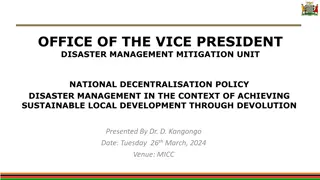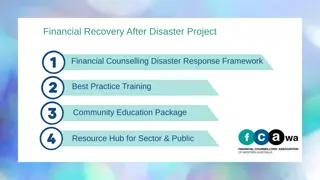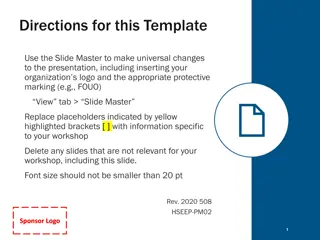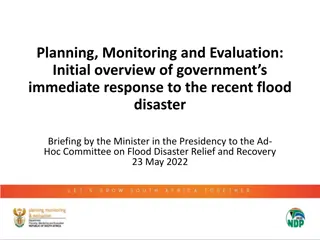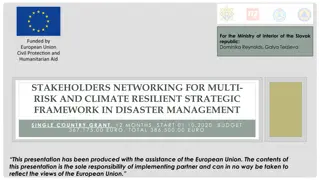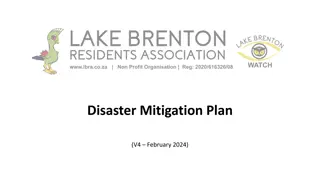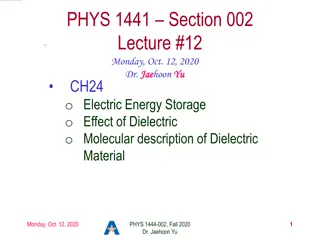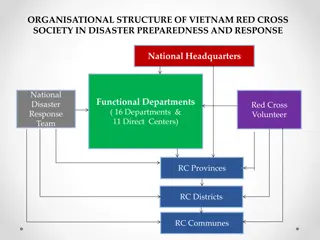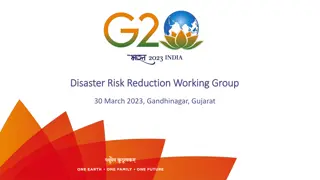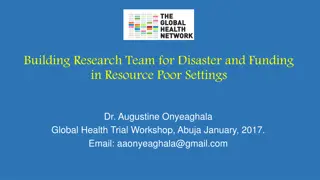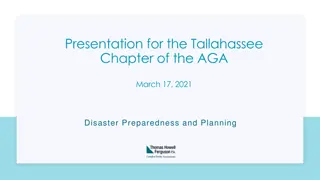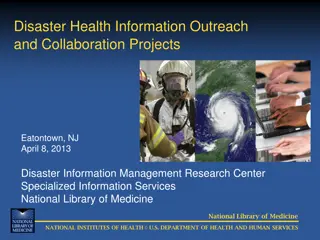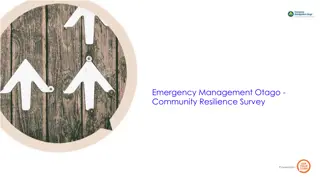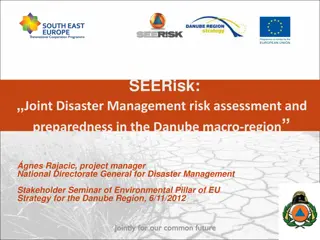
Effective Disaster Preparedness Workshop for Churches and Communities
Join the Disaster Preparedness Workshop on February 25, 2017, to learn the importance of planning, connecting vision to response, and building a disaster plan. Explore objectives, agenda, and resolutions for phases of disaster preparedness. Be part of creating a safer environment for all.
Download Presentation

Please find below an Image/Link to download the presentation.
The content on the website is provided AS IS for your information and personal use only. It may not be sold, licensed, or shared on other websites without obtaining consent from the author. If you encounter any issues during the download, it is possible that the publisher has removed the file from their server.
You are allowed to download the files provided on this website for personal or commercial use, subject to the condition that they are used lawfully. All files are the property of their respective owners.
The content on the website is provided AS IS for your information and personal use only. It may not be sold, licensed, or shared on other websites without obtaining consent from the author.
E N D
Presentation Transcript
DISASTER PREPAREDNESS WORKSHOP For Your Church, For Your Community Saturday February 25, 2017 Neil Malmquist Jeff Green
OBJECTIVES To illustrate the importance of disaster preparedness planning and to provide an overview of the planning process. To connect the congregation s vision, mission and values to disaster preparedness and response. Create the framework to build a disaster plan Identify and share congregational gifts Discuss potential needs of vulnerable people after a disaster. Brainstorm and share potential congregational responses to a disaster.
AGENDA The Diocesan Leadership in Disaster Preparedness. Diocesan resolutions and vision What Are We Planning For? It Won t Happen To Me!! Real Life Church Scenarios Need for an Effective Disaster Plan Video an effective fire evacuation plan (The Office)? Need for a Written Plan & Practice How to Build a Disaster Plan Sample Disaster Plans Don t Reinvent the Wheel Three Major Responses Evacuation Shelter in Place Respond Resources Diocesan Disaster Website Episcopal Relief & Development (ERD) U.S. Disaster Website FEMA University; CERT training; Red Cross training; Community Involvement AlertMedia Communication Congregational Gifts & Community Needs in a Disaster? Disaster Scenario
EXPLANATION OF PHASE I Churches often fill in the gap when disaster strikes. They partner with government agencies and nonprofits to provide shelter, food and other essentials during emergencies. Because they are existing communities of close-knit people with established communication channels, churches and church organizations are especially effective at distributing information, checking in with otherwise isolated people and providing emergency support. But all of this can only happen if a church has an up-to-date disaster preparedness plan. The final goal is that all congregations, institutions and offices of the diocese will have a disaster preparedness plan. However, the diocesan Disaster Preparedness Committee recognizes that every church may not be able to create a disaster preparedness plan by November 2016. Therefore, our collective goal is that the next phase of disaster preparedness planning will include completion of disaster preparedness plans by each congregation, institution and offices in the diocese by November 2017.
DISASTER PREPAREDNESS RESOLUTION PHASE II July 13, 2016 Resolved, that the 43rd Convention of the Diocese of San Diego hereby requires all congregations, diocesan institutions and offices to create an up-to-date disaster preparedness plan that includes contact information for key people, and a campus map, if applicable. Such plans are to be completed by the 44th Annual Diocesan Convention. Resolved, that the Diocesan Disaster Preparedness Committee shall support and assist congregations, institutions and offices in this effort. Resolved, that the Diocesan Disaster Preparedness Committee shall monitor congregations ,institutions and offices progress in achieving the requirements of this resolution and report the progress to the 44th Annual Diocesan Convention.
EXPLANATION PHASE II It also laid out the expectation that all congregations, institutions and offices would create an up-to-date disaster plan online by going to www.edsd.org/disaster/ and scrolling down to the bottom of the page to Additional Resources Disaster Plan Basic Template and completing your Disaster Plan prior to the 44th Diocesan Convention in 2017. To assist in this effort there will be a Disaster Planning workshop at the next Leadership Academy.
WHAT ARE WE PLANNING FOR? FIRE WILD FIRE EXCESSIVE HEAT WAVE CYBER THREAT OR ATTACK SEVERE THUNDERSTORM BOMB THREAT HURRICANE EARTHQUAKE TORNADO FLOOD CRAZY/DANGEROUS PERSON IN AREA CHEMICAL SPILL TERRORIST ATTACK VARIOUS WIND STORM (SANTA ANA WINDS) ACTIVE SHOOTER EXPLOSIONS - VARIOUS NUCLEAR BIOLOGICAL - RELEASE TSUNAMI FLU PANDEMIC LANDSLIDE CONTINUITY - RESILIENCY
IT WONT HAPPEN TO ME!!! St. Andrew s, Encinitas Nov. 12, 2016 Minor Fire Preschool Arson? Oct. 22, 2016 - Minor Fire Building Arson? St. James, La Jolla June 22, 2016 Rectory Garage Fire 1 Dead Witch Creek Wildfire Oct 2007 Evacuations of Poway, Escondido, R.B. Cedar Wildfire Oct. 2003 100 s of homes in Scripps Ranch burned St. John s, Chula Vista Apr. 1994 Church Totally Destroyed Arson St. David s, Clairemont May 1991 Church Totally Destroyed Arson St. John s Firestorm May 9, 2004The Rev. Dr. Gail Keeney- Mulligan
A DISASTER PLAN IN ACTION? https://www.youtube.com/watch?v=gO8N3L_aERg
WAS THIS A GOOD DISASTER PLAN/RESPONSE? Did they have a disaster plan? Was it effective? Was anyone in charge? Had they practiced before? Did everyone know what to do? Did anyone call 9-1-1? Did anyone pull a fire alarm? Did anyone have a fire extinguisher? Was anyone trained for a medical emergency? Are you going to make these mistakes?
HOW TO BUILD A DISASTER PLAN? Don t Re-Invent the Wheel : You re very lucky because templates have been provided for you: EDSD Basic Disaster Plan & Comprehensive Plan ERD Basic (Bronze), Intermediate (Silver) & Comprehensive Dioceses Nationwide - Disaster preparedness plan examples Something is better than nothing. Understand the Greatest Threats in Your Area Create a multi use disaster plan with 4+1 basics: Evacuation: Fire, facility weakened by earthquake, tsunami Shelter in Place: Chemical spill outside, active shooter Respond: Immediate medical situations (i.e. heart attacks) Recover (Resiliency): Preserve/protect documents & data A Season of Resilience (5 week disaster resilience plan) http://www.episcopalrelief.org/uploads/EducationFileModel/159/file/SoR- fullpage.pdf PRACTICE & UPDATE (know your plan before disaster strikes)
DISASTER PLAN LINKS EPISCOPAL DIOCESE OF SAN DIEGO DISASTER PAGE: http://edsd.org/disaster/ EPISCOPAL DIOCESE OF SAN DIEGO ASSET MAP: https://www.episcopalassetmap.org/dioceses/diocese-san-diego EPISCOPAL RELIEF & DEVELOPMENT (ERD) DISASTER RESOURCE LIBRARY: http://www.episcopalrelief.org/press-and-resources/resource- library?q=&category=5&topic=&perpage=50&useFullQuery=true DIASTER PLANNING RESOURCES: Bronze Level Preparedness Planning Guide (basic level) Silver Level Preparedness Planning guide (intermediate level) Comprehensive Preparedness Planning Guide for Congregations DISASTER PREPAREDNESS EXAMPLES: Diocese of Southwest Florida St. Gabriel Church, Colorado (Evac & SiP) Diocese of Hawaii (Evac) Diocese of Oklahoma Dioceses of Texas (Evac) Church Province IV Episcopal Church in Vermont FEMA EMERGENCY MANAGEMENT INSTITUTE: https://training.fema.gov/ FEMA FREE ONLINE EMERGENCY MANAGEMENT COURSES: https://training.fema.gov/is/crslist.aspx CITY OF SAN DIEGO COMMUNITY EMERGENCY RESPONSE TEAM (CERT): https://www.sandiego.gov/fire/services/cert/
HAZARD MAP RESOURCES My Natural Hazards By Address http://myhazards.caloes.ca.gov/ San Diego Maps - Earthquake Faults/Hazards http://www.shakeout.org/sandiego/hazards.html San Diego-Maps - FEMA Flood Zones By Address https://msc.fema.gov/portal/search San Diego Maps - Liquefaction - Fault Lines http://www.sandiegocounty.gov/oes/docs/DRAFT_COSD_Liquefactio n1.pdf
CONGREGATIONAL GIFTS & COMMUNITY NEEDS DURING A DISASTER Churches often fill in the gap when disaster strikes. They partner with government agencies and nonprofits to provide shelter, food and other essentials during emergencies. Because they are existing communities of close-knit people with established communication channels, churches and church organizations are especially effective at distributing information, checking in with otherwise isolated people and providing emergency support. But all of this can only happen if a church has an up-to-date disaster preparedness plan. Most powerful disaster response emerges when gifts of the church match the needs of the community Conversely, there may be a strong need in the community but the church lacks gifts in that area (i.e. an elderly congregation can t provide heavy machinery operators)
TRANSFERABLE CONGREGATIONAL GIFTS Congregational Gifts (the 5 P s): PEOPLE Members of your congregation/ministries Trained first responders; medical personnel; counselors People trained in First Aid/CPR/AED/CERT Contractors; carpenters, electricians, plumbers, IT guys PROPERTY Church building, parking lot, rectory, supplies Generators, trucks, trailers, boats, tools PURSE Financial assets POSTURE Church community culture: Outreach, etc. PROGRAM Ministries and activities Showers Ministry, Interfaith Shelter Network What are the gifts of: An older congregation? A small congregation? Not owning a church building?
WHAT ARE YOUR CHURCHS GIFTS? EXERCISE: Please count off and split into groups of 2 or 3 Generally speaking and using the 5 P s what are the gifts of your church or organization? PEOPLE PROPERTY PURSE POSTURE PROGRAMS Please write each gift on a separate sticky note Place your sticky note in the proper place on flip chart
NEEDS IN A DISASTER Needs change during the course of a disaster and can last for years WARNING: Communication, safe place, sand bags, building supplies, instructions RESCUE: Safety, medical care. electricity, transportation, communication (elderly) RELIEF: Food, clothing, water, shelter, childcare, warming/cooling centers RECOVERY: Rebuilding assistance, emotional support, financial assistance, data recovery MITIGATION: Reporting, analysis, training, counseling, consulting, data back ups, document storage
DISASTER SCENARIO Imagine that a disaster has struck in the area of your church: A wildfire/firestorm has been approaching for several days and many houses have been destroyed and 5 lives have been lost. The SDFD has notified residents in your vicinity that they must evacuate immediately. Please count off and split into groups again: Determine the needs of your community during each of the first 4 phases of the disaster life cycle. Write answers on sticky notes Then brainstorm your church gifts to address some or all of these needs. Write answers on sticky notes Try to focus on the needs of people who may be more vulnerable to disasters than others
CONTINUING AWARENESS & EDUCATION Become Involved With The Local Emergency Response Community Ready San Diego Sign up for disaster alerts by e-mail & phone: http://www.readysandiego.org/alertsandiego/ Community Emergency Response Team (CERT): San Diego City: https://www.sandiego.gov/fire/services/cert/ Volunteer Organizations Active in a Disaster (VOAD): http://sdvoad.org/ American Red Cross of San Diego & Imperial Counties http://www.redcross.org/local/california/san-diego Sign up for Shelter Operations training
CONCLUSIONS Episcopalians have gifts. Lots of them !!!! Needs change over the course of a disaster. Be sure to keep checking in with folks who are affected by disasters and ask what they need. The two strongest indicators that predict whether or not a church will respond after a disaster are: An awareness of congregational gifts & limitations A willingness to try, Don t hesitate to help out In order for your church to be of benefit to the community it must first have a plan in place to survive and recover from disasters. In some cases first responders will be overwhelmed and people may have to survive by themselves for weeks. QUESTIONS?



